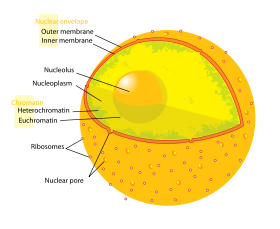
Inner membrane
Encyclopedia



Biological membrane
A biological membrane or biomembrane is an enclosing or separatingmembrane that acts as a selective barrier, within or around a cell. It consists of a lipid bilayer with embedded proteins that may constitute close to 50% of membrane content...
(phospholipid bilayer) of an organelle
Organelle
In cell biology, an organelle is a specialized subunit within a cell that has a specific function, and is usually separately enclosed within its own lipid bilayer....
or Gram-negative
Gram-negative
Gram-negative bacteria are bacteria that do not retain crystal violet dye in the Gram staining protocol. In a Gram stain test, a counterstain is added after the crystal violet, coloring all Gram-negative bacteria with a red or pink color...
bacteria
Bacteria
Bacteria are a large domain of prokaryotic microorganisms. Typically a few micrometres in length, bacteria have a wide range of shapes, ranging from spheres to rods and spirals...
that is within an outer membrane
Outer membrane
The bacterial outer membrane is found in Gram-negative bacteria. Its composition is distinct from that of the cytoplasmic membrane - among other things, the outer leaflet of the membrane includes a complex lipopolysaccharide whose lipid portion acts as an endotoxin - and it is linked to the cell's...
.
In eukaryotic cells, this inner membrane is present within the nuclear envelope
Nuclear envelope
A nuclear envelope is a double lipid bilayer that encloses the genetic material in eukaryotic cells. The nuclear envelope also serves as the physical barrier, separating the contents of the nucleus from the cytosol...
, mitochondria and plastid
Plastid
Plastids are major organelles found in the cells of plants and algae. Plastids are the site of manufacture and storage of important chemical compounds used by the cell...
s like the chloroplast
Chloroplast
Chloroplasts are organelles found in plant cells and other eukaryotic organisms that conduct photosynthesis. Chloroplasts capture light energy to conserve free energy in the form of ATP and reduce NADP to NADPH through a complex set of processes called photosynthesis.Chloroplasts are green...
. The lumen between the inner and outer membranes is referred to as intermembrane space
Intermembrane space
The intermembrane space also known as IMS is the region between the inner membrane and the outer membrane of a mitochondrion or a chloroplast. The main function of the intermembrane space is oxidative phosphorylation....
.
In prokaryotic
Prokaryote
The prokaryotes are a group of organisms that lack a cell nucleus , or any other membrane-bound organelles. The organisms that have a cell nucleus are called eukaryotes. Most prokaryotes are unicellular, but a few such as myxobacteria have multicellular stages in their life cycles...
cells such as many Gram-negative bacteria, the space between the inner and outer membrane is commonly referred to as the periplasmic space
Periplasmic space
The periplasmic space or periplasm is a space between the peptidoglycan cell wall and inner membrane of Gram-negative bacteria or the equivalent space outside the inner membrane of Gram-positive bacteria. It may constitute up to 40% of the total cell volume in Gram-negative species, and is...
or periplasm. The inner membrane may also be referred to as the cytoplasmic membrane
Cell membrane
The cell membrane or plasma membrane is a biological membrane that separates the interior of all cells from the outside environment. The cell membrane is selectively permeable to ions and organic molecules and controls the movement of substances in and out of cells. It basically protects the cell...
and it is similar in structure and protein content as the cytoplasmic membrane of other bacteria that contain only one membrane (such as most Gram-positive
Gram-positive
Gram-positive bacteria are those that are stained dark blue or violet by Gram staining. This is in contrast to Gram-negative bacteria, which cannot retain the crystal violet stain, instead taking up the counterstain and appearing red or pink...
bacteria).
This structural arrangement of an inner and outer membrane is thought to be similar in Gram-negative bacteria, mitochondria and chloroplasts due to their ancestral relationship, as outlined in the endosymbiotic theory
Endosymbiotic theory
The endosymbiotic theory concerns the mitochondria, plastids , and possibly other organelles of eukaryotic cells. According to this theory, certain organelles originated as free-living bacteria that were taken inside another cell as endosymbionts...
.
The inner membrane of the nuclear envelope
Nuclear envelope
A nuclear envelope is a double lipid bilayer that encloses the genetic material in eukaryotic cells. The nuclear envelope also serves as the physical barrier, separating the contents of the nucleus from the cytosol...
is connected to the outer nuclear envelope membrane through nuclear pore
Nuclear pore
Nuclear pores are large protein complexes that cross the nuclear envelope, which is the double membrane surrounding the eukaryotic cell nucleus. There are about on average 2000 nuclear pore complexes in the nuclear envelope of a vertebrate cell, but it varies depending on cell type and the stage in...
s. It contains a number of proteins involved in the structural organization of the nucleus and the attachment of chromatin
Chromatin
Chromatin is the combination of DNA and proteins that make up the contents of the nucleus of a cell. The primary functions of chromatin are; to package DNA into a smaller volume to fit in the cell, to strengthen the DNA to allow mitosis and meiosis and prevent DNA damage, and to control gene...
to the nuclear envelope. In metazoan cells, the inner nuclear membrane contains proteins of the nuclear lamina
Nuclear lamina
The nuclear lamina is a dense fibrillar network inside the nucleus of a eukaryotic cell. It is composed of intermediate filaments and membrane associated proteins. Besides providing mechanical support, the nuclear lamina regulates important cellular events such as DNA replication and cell division...
, a protein meshwork underlying the nuclear envelope and providing structural support. Mutations in inner nuclear envelope proteins can cause nuclear envelopathies, a number of genetic disorder
Genetic disorder
A genetic disorder is an illness caused by abnormalities in genes or chromosomes, especially a condition that is present from before birth. Most genetic disorders are quite rare and affect one person in every several thousands or millions....
s in humans.
See also
For eukaryotes
- Intermembrane spaceIntermembrane spaceThe intermembrane space also known as IMS is the region between the inner membrane and the outer membrane of a mitochondrion or a chloroplast. The main function of the intermembrane space is oxidative phosphorylation....
- Chloroplast membraneChloroplast membraneChloroplasts contain several important membranes, vital for their function. Like mitochondria, chloroplasts have a double-membrane envelope, called the chloroplast envelope. Each membrane is a phospholipid bilayer, between 6 and 8 nm thick, and the two are separated by a gap of 10-20 nm,...
For bacteria
- periplasmic spacePeriplasmic spaceThe periplasmic space or periplasm is a space between the peptidoglycan cell wall and inner membrane of Gram-negative bacteria or the equivalent space outside the inner membrane of Gram-positive bacteria. It may constitute up to 40% of the total cell volume in Gram-negative species, and is...
- outer membraneOuter membraneThe bacterial outer membrane is found in Gram-negative bacteria. Its composition is distinct from that of the cytoplasmic membrane - among other things, the outer leaflet of the membrane includes a complex lipopolysaccharide whose lipid portion acts as an endotoxin - and it is linked to the cell's...

